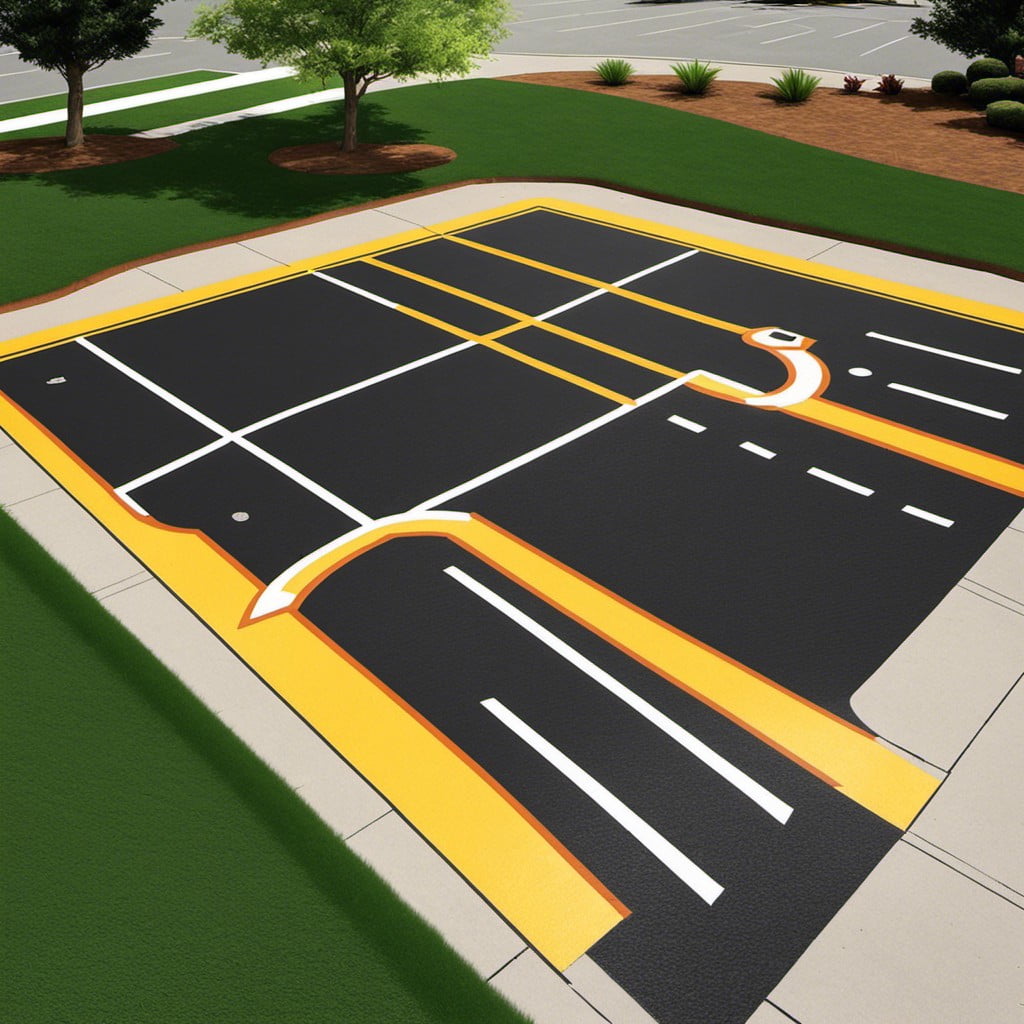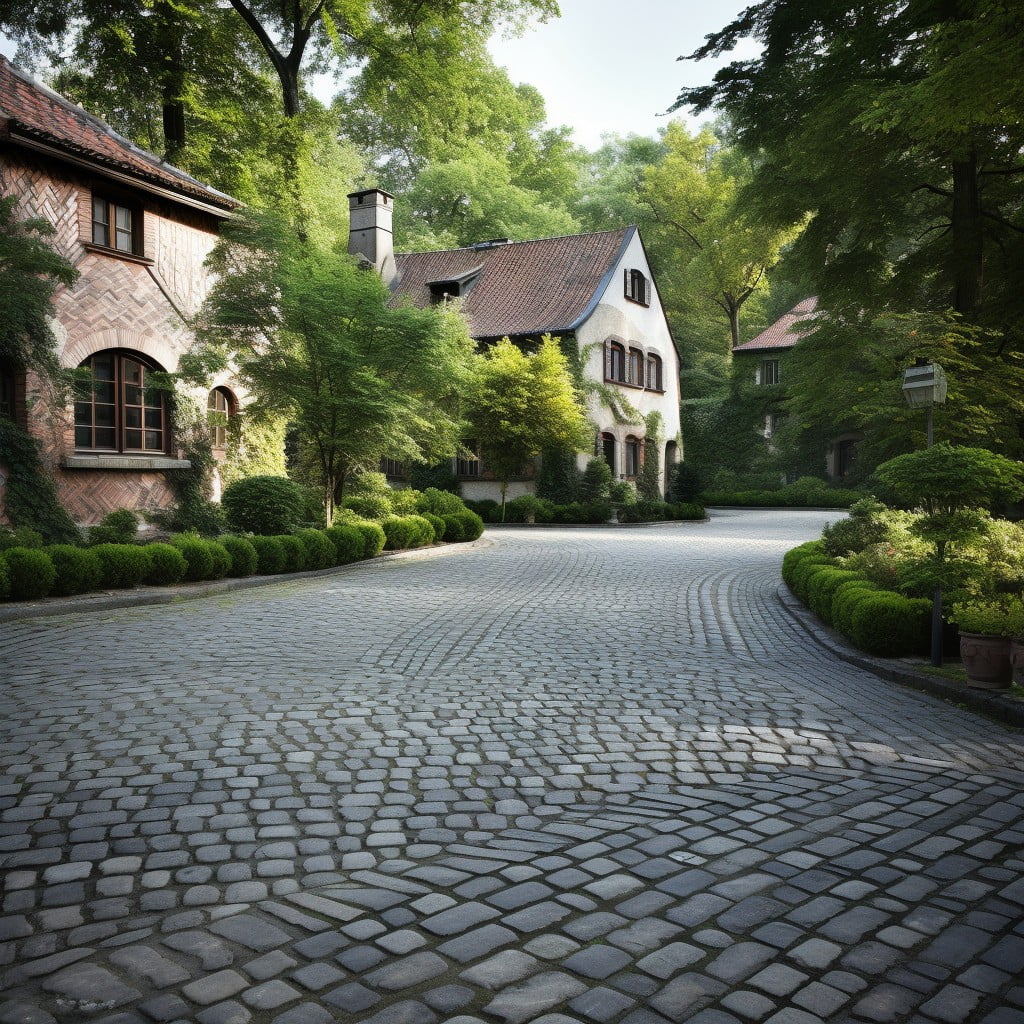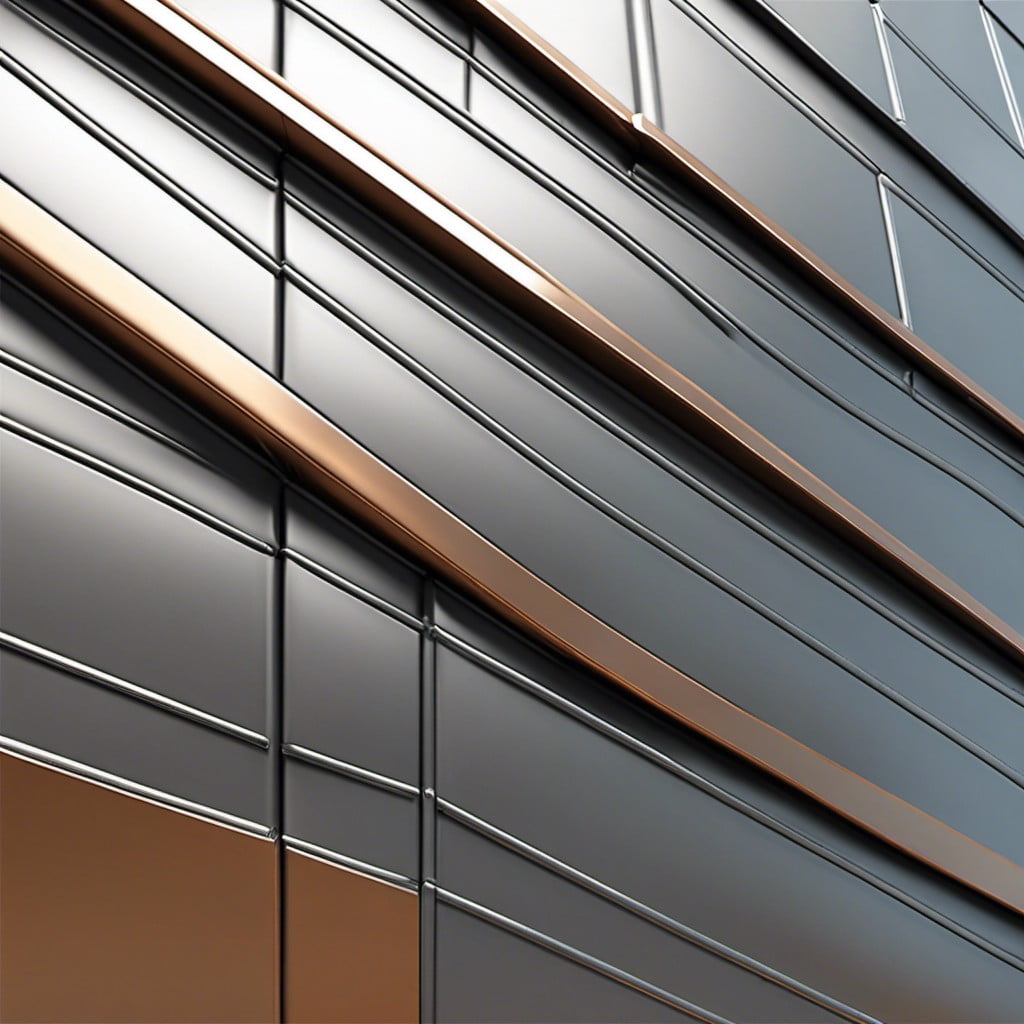Explore innovative design ideas to transform your ordinary parking pad into a visually appealing and functional space.
Transforming your home’s exterior with a stylish parking pad can add both functionality and aesthetic appeal. This article will delve into an array of design ideas, from the use of eco-friendly permeable pavers to the incorporation of green spaces and lighting elements.
Whether you’re working with a compact city space or a sprawling suburban driveway, you’ll find inspiration to suit your needs. We’ll cover materials, layout, and even tips on how to blend your parking pad seamlessly with your home’s overall design.
So, let’s roll up our sleeves and revamp that parking pad into a stylish statement piece.
Paver Stone Parking Pad

A reliable and visually pleasing option, paver stones boast versatility, allowing homeowners to personalize shapes, patterns, and colors. They withstand weight stress effectively and offer easy maintenance and replacement.
Here are some key points to consider:
- 1. Variety of material choices including concrete, brick and natural stone.
- 2. Flexibility in creation of unique layouts and designs.
- 3. High durability and load-bearing capacity.
- 4. Easy repair, simply replace individual stones if damaged.
- 5. Provides optimal drainage preventing surface water accumulation.
- 6. Higher upfront cost offset by longevity and minimal maintenance.
Grass and Concrete Grid

A perfect blend of natural appeal and durability, this option provides an arrangement of concrete grids often filled with soil and grass. Here are key points behind its popularity:
- Durability: Concrete grids are solid, strong and resilient, capable of withstanding heavyweights like that of an SUV.
- Eco-friendliness: Grass within the grid contributes to lower surface temperature and aids in stormwater runoff, a sustainable choice.
- Aesthetics: Offers a laid-back, natural look, with greenery adding a touch of sophistication.
- Easy Maintenance: Regular lawn care practices such as watering and trimming keep it looking spiffy.
- Drainage: Excellent water dispersal, as grass allows water to be absorbed into the ground, no concerns of pooling water or erosion.
- Balances Nature and Utility: While serving as a robust parking pad, the grass softens the look, making it a pleasant outdoor element.
Gravel Surface Pad

Gravel, as a popular choice for parking pads, offers multiple advantages.
- Affordable: Less expensive when compared to materials like concrete or paver stone.
- Drainage: Inherent ability to facilitate water run-off, reducing risk of pooling.
- Easy installation: Can be spread and levelled without professional help.
- Versatility: Comes in varying sizes and colors to match home exteriors.
- Maintenance: Easy to top up as needed, making it a practical option long term.
However, it’s important to consider potential downsides, such as the need for regular weed control and the risk of gravel displacement.
Despite these challenges, a gravel parking pad remains a highly effective, cost-savvy solution for many homeowners looking to improve their outdoor parking setup.
Asphalt Parking Pad

Optimal balance between affordability and durability is offered by asphalt. It allows for such benefits as:
- Resistance to wear and tear, capable of withstanding heavy vehicle weight.
- Excellent drainage capability, preventing water accumulation that can cause damage.
- High level of maintenance simplicity; cracks or potholes can be repaired swiftly.
- Affordable installation costs compared to certain other materials.
- Aesthetically versatile, asphalt can be paired with decorative edges for enhanced curb appeal.
- Heat absorption, making it ideal for snowy areas as snow melts faster.
Overall, asphalt proves a practical choice for homeowners seeking cost-effective, durable solutions for their parking pad designs.
Circular Brick Design

Complementing any home, the circular brick design brings a certain aesthetic charm that suits both modern and traditional styles.
Key points:
- Use guidelines: Lay down chalk or string as a guide to place your bricks in the perfect circle.
- Overlapping: Overlap bricks slightly, creating a stable, interlocked pattern for longevity.
- Sand foundation: Spread a thick layer of sand as a base to ensure bricks settle correctly.
- Wide border: Consider a wide border of single bricks, outlining the circle to enhance visual impact.
- Proper drainage: Implement a slight slope or in-built channels to avoid standing water.
Ensure a professional or experienced DIYer conducts the task to guarantee a solid, durable result. With perfect execution, this parking pad design can significantly boost your home’s curb appeal.
Permeable Parking Pad

Regarded as a green addition to your home, permeable parking pads provide an environmentally friendly solution. This design option can at once add an aesthetic value and support water conservation efforts.
- Allows quick absorption, reducing runoff
- Recycles rainwater, aiding gardens and lawns
- Reduces heat island effect, promoting cooler surroundings
- Provides hard-wearing, durable surface
- Low maintenance, time and cost-effective in the long run
These unique attributes make permeable parking pads a compelling choice for homeowners seeking a balance between style and sustainability.
Cobblestone Finish

Cobblestone offers a timeless, classic aesthetic that’s both visually appealing and durable. This option is often comprised of granite, which ups the curb appeal due to its distinctive, irregular-shaped stones.
- Aesthetics: Vintage look that offers charm and character.
- Durability: Withstands high traffic and element exposure.
- Maintenance: Hassle-free, typically only requires occasional sweeping.
- Installation: Professional install recommended due to heavy and irregularly-shaped stones.
- Cost: Pricier end due to material expense but balance out by low maintenance and longevity.
Extended Driveway Design

Maximizing property space is central to this design, allowing for additional parking capacity beyond the ordinary driveway. By extending your driveway, it can incorporate multiple vehicles or potentially a motorhome or boat.
1. Similar material choice for a seamless upgrade.
2. Consideration for gradient, soil composition in the construction process.
3. Zone permissions and local regulations.
4. Drainage arrangements to prevent water pooling or runoff.
5. The addition of carports or shading structures for vehicle protection.
6. Landscaping integration for a refined aesthetic appeal.
Decorative Concrete

Switching to decorative concrete can provide versatile design elements for your parking pad. Its versatility extends beyond the simplistic view that it’s just grey and flat. Here are several key points to consider:
1. Material Diversity: Decorative concrete holds the capacity to imitate higher-end materials like stone, brick, or wood at a fraction of their usual cost, presenting an affordable yet high-quality option.
2. Aesthetic Enhancement: Incorporating colors, textures, patterns, or even logos can elevate your parking pad’s visual appeal.
3. Maintenance Simplicity: Its durability and resistance to damage from cars or weather conditions ensure lower maintenance costs over time.
4. Resale Value: A stylish parking pad can significantly boost your property’s resale value as prospective buyers appreciate unique exterior features.
5. Environment-Friendly: Its ability to incorporate recycled materials during the manufacturing stage can contribute to your efforts in pursuing green choices.
6. Safety: It offers an anti-slip surface, providing a safer spot for vehicle parking, especially during rainy or wintry conditions.
Overall, choosing decorative concrete brings a transformative touch to your exterior space design, combining affordability, durability, and aesthetic value.
Eco-friendly Green Pad

Adopting an eco-friendly approach to parking pad construction involves several key aspects:
- Materials: Use permeable materials like gravel, permeable pavers, or grass grid systems which allow water to pass through, reducing runoff and replenishing groundwater.
- Drainage: Incorporate a proper drainage system. A rain garden or swale near the parking area cuts water pollution.
- Native Plants: Consider bordering the parking pad with native plants to improve aesthetics and enhance local biodiversity.
- Maintenance: Eco-friendly green pads require minimal maintenance, making them a practical choice.
- Carbon Footprint: Building materials and methods used reduce the overall carbon footprint, contributing to sustainability efforts.
- Durability: Materials used in eco-friendly pads often last longer than traditional parking pad materials, reducing the need for replacement or repairs.
- Flexibility: These parking pads can be customized according to the property’s dimensions and needs.
Opting for an eco-friendly green pad balances both environment-friendly solutions and aesthetics, making them a sustainable choice for any homeowner.
Stamped Concrete Designs

Offering durability and maintenance ease, this particular design becomes an instant hit for many. Its aesthetic potential lies in the unique patterns mimicking high-end materials like brick, cobblestone, or natural slates, which bring a luxurious touch to your parking pad.
Key Points:
- Mimics a variety of materials.
- Delivers high durability.
- Requires minimal maintenance.
- Provides limitless designs.
- Enhances home exterior aesthetics.
- Cost-effective alternative to premium materials.
Remember, customization possibilities remain limitless to match your style and home’s overall aesthetics, offering an elegant and high-end look without the associated cost. After all, who doesn’t want to increase their home’s curb appeal while staying practical and economical? A win-win indeed.
Natural Stone Pad

Choosing the right natural stone, such as granite, slate, or sandstone, adds an undeniable elegance to the parking pad. Its high durability and natural variations in color provide both functional and aesthetic appeal.
1. Texture and color diversity: Each stone presents an array of unique hues and textures.
2. Durability: Can effectively handle the weight and friction of vehicles.
3. Low maintenance: No need for regular re-painting or re-sealing.
4. Increased property value: Stone elevates curb appeal and property worth.
5. Flexible design options: Stones can be arranged in various patterns.
Herringbone Brick Pattern

This design presents a distinctive and elegant look for your parking pad. The key points are:
1. The herringbone pattern requires arranging the bricks in a V-shape, which not only looks appealing but also provides a sturdy base, resisting movement from vehicles.
2. Bricks for this pattern are usually rectangular, with the 45-degree or 90-degree herringbone patterns being the most common.
3. A variety of brick colors can cater to individual style preferences, ranging from traditional red and brown to more modern greys and whites.
4. Though the cost might be slightly higher than some other options due to the complexity of the design, the durability and aesthetic appeal of the herringbone pattern make it a worthwhile investment.
5. Regular maintenance includes checking for loose or chipped bricks and replacing them as needed. It’s also advised to clean the bricks occasionally to prevent the growth of moss or algae.
6. The pattern has a significant advantage: any oil or rubber marks from the car are less noticeable due to the intricate design, which ultimately keeps your parking pad looking clean for longer.
Border Accented Pad

A border accent, typically constructed with a contrasting material or color, gives a neat, finished look. The selection of material ranges from brick, cobblestone, to decorative concrete, which can complement the central pad area – often the same material but in a different shade or pattern.
Before laying out the border, use a string or garden hose for positioning guidance.
Key points:
- Highlights the parking area, adds aesthetic appeal.
- Contrasting or complementary materials and colors.
- String or garden hose for border positioning.
- Use of the same foundation material to ensure stability.
- Easy to install and replace when necessary.
- Suitable for various shapes and sizes of pads.
- Versatility in design – zigzag, round, straight or curved.
Reinforced Turf

A top choice for the environmentally conscious homeowner, this option blends aesthetics and functionality seamlessly.
Key points:
- Undeniably eco-friendly, employs a grid system filled with soil and seeded with grass.
- Ensures durability and longevity, even under frequent vehicle pressure.
- Minimizes water runoff, promotes natural water filtration into the soil.
- Complements the surrounding green space, maintains an uninterrupted grassy vista.
- Requires regular mowing and maintenance, similar to a normal lawn.
- Offers a variety of grid materials like plastic or concrete for selection.
- Suitable for both light passenger cars and heavier recreational vehicles.
- Must consider local climate and type of grass for optimal growth and resilience.
Resin-bound Surface

Offering a contemporary and sleek aesthetic, the resin-bound surface affords a low-maintenance, durable solution for your home’s parking pad. Key factors to consider include:
- Durable Material: The combination of aggregate stones and resin forms a robust, lasting surface able to withstand heavy vehicle weight.
- Versatile Appearance: Resin-bound surfaces provide a range of flexible colour and texture options to match your home’s exterior.
- Permeability: The nature of the surface facilitates efficient drainage, reducing the risk of standing water or puddles.
- Low Maintenance: The surface is resistant to weeds, oil spills, and moss, making cleaning a breeze.
- Cost-Effective: While the initial investment is substantial, the minimized maintenance and longevity ensure an economical long-term option for your parking pad.
With these in mind, don’t forget to incorporate the resin-bound surface concept into your overall parking pad design landscape.
Wood Chip Surface

Wood chips present an eco-friendly and cost-effective option for designing a parking pad. Known for their permeability, they reduce water runoff and facilitate groundwater replenishment.
1. Easy installation: Unlike other methods, wood chip pads require minimal professional intervention.
2. Cost-effective: Wood chips are readily available and cheaper than concrete or asphalt.
3. Environment friendly: They are biodegradable, resulting in a minimal environmental footprint.
4. Aesthetic appeal: Adds a rustic appeal to the house exterior.
5. Cushion effect: Gentler on the tyres compared to hard surfaces.
Maintain the quality of your parking pad by periodically raking the chips and replenishing when required. This ensures longevity and a neat appearance. Remember, using treated wood chips deters insects and prolongs the life of the pad. Wood chip surfaces are not ideal for high traffic areas or places with heavy rainfall, they can be displaced or washed away. Consider other options if you’re in such regions.
Checkerboard Style

The checkerboard design, popular for its unique, eye-catching appeal, is synonymous with a clear and ordered layout. The process involves alternating squares of two contrasting materials.
Key points:
- Use of two different materials: commonly, black and white paving stones are alternated for the classic checkerboard look, but there’s room to get creative with colors and materials.
- Precise Square sections: each square, regardless of the material, needs to be of the exact same size both in length and in width, thereby maintaining uniformity.
- Installation pattern: the squares should be placed alternately, creating a continuous checkerboard pattern throughout.
- Maintenance: keeping the pattern well-aligned, clean, and intact will ensure the design remains aesthetically pleasing and safe to use.
- Can be used for both large and small spaces: It’s scalable and thus a versatile design choice.
Heated Parking Pads

Offer significant convenience especially in snowy regions. Consist of heating cables or tubing installed underneath the pad surface.
Require an energy source – either gas or electric. Ensure easier, safer winter parking and mobility.
Reduce time and effort clearing snow. Reduce potential for slips and falls. May increase property value due to unique feature.
Have potential for energy-efficient options – geothermal heat pump systems. Demand professional installation for both safety and functionality.
Require certain maintenance, particularly electrical systems. Offer limited design options—typically concrete or asphalt.
Custom Painted Asphalt

Durable and weather-resistant, making it an optimal choice for outdoor use. To create a unique look, stencils and painters tape are utilized. Professionals often handle the painting to ensure adequate, uniform coating. The paint used is special asphalt paint, ensuring it doesn’t chip away or erode quickly. The design possibilities are virtually endless – from basic geometric patterns to intricate artistic designs. Allows personal expression and adds a visual appeal to an otherwise mundane parking pad.
Consider upkeep, as regular maintenance is required to keep the design vivid. Requires cleansing before painting to remove grime or oil that might inhibit adhesion. Application during warm and dry weather conditions ensures longevity of the custom design.
Continue exploring:




